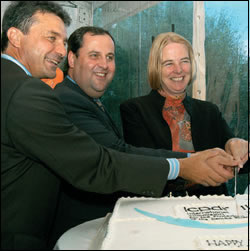 |
Catherine Day, ICPDR President;
Josef Pröll, Austrian Minister for Environment; and Philip Weller,
ICPDR Executive Secretary, cut the cake to celebrate ten years of
the Danube River Protection Convention. |
What we witnessed in all Danube countries this June 29 was more than a
single day, it was an output of a development. It was an expression of an
increasingly transboundary feeling of being in the same boat and living
along the same river. Festivities all along the river brought people together
and raised awareness for the interdependence of what we do in farms and
yards, in mountains and flood plains, and how the river’s biodiversity
develops.
Linking hearts and nations
Ten years after convention negotiations officially ended, Central Europe
is a different place. The EU has grown eastwards; boundaries that separated
destinies in the past are less than a line on the map. The Danube, as the
most international river worldwide, brought its 80 million inhabitants closer
to each other. The river has become a symbol for connecting people, for
narrowing disagreements, for bridging gaps. This first Danube Day brought
festivities to every country in the Danube River basin. Catherine Day, ICPDR
President and Director General for DG Environment of the European Commission,
opened the official festivities in Vienna. Although bad weather meant cancellation
of activities planned on the water, there was no setback in the mood.
Catherine Day and Josef Pröll, Austrian Minister of Agriculture, Environment
and Water Management, highlighted what they called "basin solidarity”,
a common feeling among people living in the Danube basin. This feeling has
deep roots in Austria. The Danube gave its name to the world-famous Viennese
waltz and the river was the backbone of the Habsburg Empire for centuries.
Therefore, it’s natural for Austrians to see the Danube as a link
between different nations.
Celebrating together
Today the river is a link between independent nations that voluntarily come
together closely. To celebrate this, the International Association of Danube
Research organised a cycling tour from Vienna to Bratislava with many stops
along the way to enjoy the magnificent scenery that connects these two towns.
In Vienna, the Nordbahn Bridge was transformed into a Danube extravaganza;
filled with evocative sights, sounds and smells from every country of the
basin. Electronic cellist Wolfram Huschke performed his unique music, as
guests from Austria and neighbouring countries enjoyed an international
buffet, prepared by the embassies of the Danube countries. Although Danube
Day did not attract the crowds that the annual Donaufest usually does, the
celebration in Vienna was a great mosaic, vivid and colourful. Music, discussions,
dancing and fun combined to honour a great river and its peoples.
Much work to be done
The river’s story continues to grow, however, and as some problems
are solved, many new ones arise. As ICPDR President Day put it: "A
lot has to be done and it will cost very much money.” Unlike the early
1990s, however, more is known today about what needs to be done and more
tools exist to help. "Within the member countries there is no question
about the EU Water Framework Directive,” said Day. This EU directive
highlights an interdisciplinary approach for politicians, scientists and
citizens to protect the Danube.
To meet this directive, agriculture must be adapted as well as spatial planning,
wastewater treatment and industrial development. Day promised assistance
would be given "to countries which have not joined the EU, to fulfil
the directive’s standards”. She added, however, "at this
stage some 50 to 85 percent of the Danube River basin does not meet what
is required by the directive. There is still time until 2015 when the directive’s
targets have to be met.”
Dangers lurking along the shore
The EU has voiced "deep concern” for the growing threats in the
Danube region. Booming economies in the countries which have just joined
the EU and which are preparing to do so may endanger the fragile ecology
and can tremendously increase pressure on the environment. One of the most
visible threats throughout the river basin is also the one growing most
rapidly: traffic. Catherine Day calls climate change, caused to a significant
extent by traffic emissions, "the most important issue in our time”.
As the climate changes, rivers become more important, she believes.
Through changing patterns of rain and snow, rivers will play a crucial role
during floods, which will be more likely in a warmer world. Day said one
consequence
is quite clear, "We have to protect what has remained of the rivers’
floodplains.” The EU will also emphasise adaptation and will develop
a ‘Flood Action and Prevention Plan’, which will aim to improve
information, declaration of areas in danger and detailed plans of management
in these areas. Catherine Day’s intention is clear: "We have
to move all our activities into a more sustainable direction.”